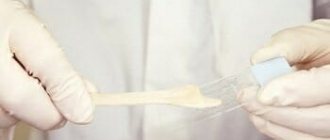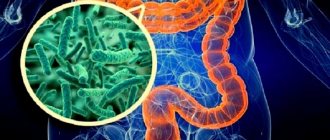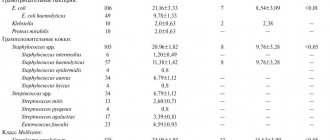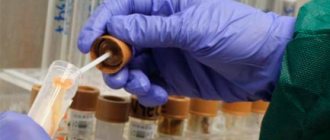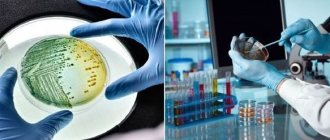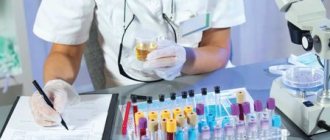In what cases is culture for dysbacteriosis usually prescribed?
Cultures for dysbacteriosis are carried out to identify imbalances in the intestinal microflora and are based on determining the quantitative composition of the main bacteria inhabiting the intestines. The results obtained are compared with normal values. In order to assess the dynamics of indicators, stool culture for dysbacteriosis is carried out no earlier than 2 weeks after the end of therapy with antibiotics or bacteriophages.
Dysbacteriosis (imbalance of normal intestinal flora) in adults and children can be associated with disruption of the liver, biliary tract, stomach, and pancreas.
Signs of dysbiosis may accompany the following conditions:
- parasitic infestations, including giardiasis;
- chronic infections, for example, carriage of staphylococcus;
- allergies;
- hypovitaminosis;
- diabetes;
- after taking antibiotics.
Intestinal dysbiosis can manifest itself as constipation, diarrhea, flatulence, pain and other disorders.
What is enterobiasis
Enterobiasis is a parasitic disease. The causative agent is pinworms - helminths of the nematode class. The life cycle of parasites is 30 days and begins after the egg enters the human gastrointestinal tract.
Pinworms of different sexes are able to move freely through the intestines to mate. Females parasitize the colon because they often use the skin in the anal area to lay eggs. For this reason, feces are rarely submitted for testing for enterobiasis, since they do not provide complete information.
Mature females lay eggs at night. The muscles of the anus are relaxed at this time, which allows the helminth to freely escape to the surface of the skin. Then the female dies. Infection with pinworms most often occurs in the household when parasite eggs get on hands, linens (bed and underwear), floors, carpets, or a children's potty.
Definition
Bacteriological culture
- a method for studying biological material (blood, urine, feces, etc.) taken from a patient and placed on an artificial nutrient medium that promotes the growth and reproduction of the pathogen.
The study can reveal not only the presence of the pathogen, but also its concentration. This way you can explore:
- feces, urine, blood
- cerebrospinal fluid (CSF)
- sputum
- bile
- discharge from the throat, nose, eyes, respiratory tract, genitals, wounds.
That is, microorganisms can be inoculated from almost any part of the body. Such techniques are convenient for finding and identifying bacteria and fungi; detecting viruses in this way is much more difficult, which is due to the peculiarities of the biology of viruses.
Normal values
Different laboratories use different units of measurement and reagents to evaluate biochemical blood test parameters. Therefore, it is advisable to clarify the analysis standards directly in the laboratory. Standard standards for biochemical blood analysis:
- blood glucose: 4.22–6.11 mmol/l;
- sialic acids: 2.0–2.33 mmol/l;
- lactic acid: 0.99–1.75 mmol/l;
- total lipids: 4–8 g/l;
- total cholesterol: <5.2 mmol/l;
- high density lipoproteins: 0.9–1.9 mmol/l;
- low density lipoprotein: <2.2 mmol/l;
- triglycerides: 0.5–2.1 mmol/l;
- non-esterified fatty acids: 400–800 µmol/l;
- total protein: 70–90 g/l;
- albumins: 56.5–66.5%;
- globulins: 33.5–43.5%;
- seromucoid: 0.13–0.20 units;
- creatinine: 50–115 µmol/l;
- urea: 4.2–8.3 mmol/l;
- uric acid:
- men 214–458 µmol/l;
- women 149–404 µmol/l;
- total bilirubin: 8.5–20.5 µmol/l;
- direct bilirubin: 0–5.1 µmol/l;
- indirect bilirubin: up to 16.5 µmol/l;
- sodium: 135–152 mmol/l;
- potassium: 3.6–6.3 mmol/l;
- calcium: 2.2–2.75 mmol/l;
- magnesium: 95–110 µcol/l;
- chlorides: 95–110 mmol/l;
- Serum ferritin:
- women 12–150 µg/l;
- men 15–200 µg/l;
- total iron-binding capacity of serum: 50–84 µmol/l.
How often should you get tested?
Although the validity period of the test for enterobiasis is limited to 10 days, the frequency of its delivery depends on the requirements of a particular child care institution.
A child of kindergarten age should be scraped for pinworm eggs at least once a year
Organized children of preschool age are required to undergo testing for the presence of helminthic infestation once a year. Additional scraping may be required if the child has not attended kindergarten for quite a long time.
It is mandatory to undergo an enterobiasis test when applying for a sanitary-resort card if the child goes on vacation to a camp or sanatorium. If your baby has symptoms of pinworm infection, you should visit your pediatrician and get a referral for a scraping.
Indications for analysis
Although the life cycle of one parasite is only 30 days, the disease itself can last for years. The reason is repeated self-infection as a result of scratching the anal area and the transfer of eggs.

If a child does not sleep well at night and has scratching in the anal area, this is a reason to be tested for enterobiasis.
In children, testing for enterobiasis is prescribed in the following cases:
- itching in the anal area that occurs at night. Such sensations are explained by the female coming out. The severity of the itching can vary: it depends on the degree of infection. Not only the anal area, but also the entire perineum can itch;
- when scratching appears on the skin around the anus;
- soreness of scratched areas;
- nausea, vomiting, rumbling in the abdomen, stool disorders - diarrhea/constipation;
- increased irritability, fatigue, restless night sleep;
- urinary incontinence, fainting - in advanced cases;
- weight loss with normal appetite.
..
Sometimes a child develops signs of appendicitis - abdominal pain, nausea, fever. Inflammation of the appendix can cause the accumulation of adult parasites in it. In this case, surgical intervention can be avoided. The child will be prescribed anthelmintic medications.
When inflammation of the organs of the female reproductive system is detected in little girls, a test for enterobiasis is mandatory for the child. In childhood, the symptoms of pinworm infection are especially pronounced.
How to get tested
You can get tested for enterobiasis at any medical institution. This could be a district clinic, an SES department, or a paid medical office. On the day of delivery of the material, you cannot hygienically wash the child. It is also undesirable to allow him to empty his bowels and urinate.
Considering the fact that pinworms become especially active early in the morning, in some cases parents take the test themselves.
How can I do that? First of all, you need to purchase in advance a sterile test tube with a special cotton swab or glass with adhesive tape applied to it. You can buy them at the pharmacy. If you plan to get tested for enterobiasis at a private clinic, you can get containers from them.
You need to take a smear from the child before he gets out of bed, lying on his side. The likelihood of finding pinworm eggs increases if he had a restless sleep that night. How is scraping taken for enterobiasis in children? There are two methods:
- using a test tube and a stick;
- using adhesive tape.

In some cases, you can take a scraping for enterobiasis yourself, for example, if the child is afraid of doctors
If we talk about how to take an analysis with a cotton swab, the scheme will be as follows:
- Lay your baby on his side.
- Take the stick out of the test tube and hold it in your hand without touching the cotton wool.
- Using your free hand, gently spread your buttocks apart.
- Circle the stick around the anus, applying slight force.
- Place the stick in the test tube and close it tightly.
[node:field_field_doprekl]
The second way to collect material is with adhesive tape. The scheme will be like this:
- Remove the tape from the slide, being careful not to touch it at all.
- Spread the child's buttocks and place the tape with the sticky side on the anus area and press lightly.
- Carefully peel it off and place the sticky side on a glass slide.
- Pack it in a bag.
Young children may be prescribed a stool test for enterobiasis. It is best to collect material for laboratory research in the morning, but as an exception, you can also use the evening portion. It is necessary to store feces at a temperature of +3…+8 °C.
Before defecation, the child must first empty the bladder so that excess fluid does not enter the stool. This may distort the analysis results.

After the material has been collected, it must be urgently delivered to the laboratory; tests performed within 50 minutes after its collection will be most accurate.
Method of collecting biological material for testing for the presence of pinworm eggs:
- the pot must be washed thoroughly;
- then the child can empty the intestines into it;
- using a sterile spoon - you will need to purchase a special kit in advance at the pharmacy - take feces, but you need to collect it from different parts of the feces;
- close the container with a lid and deliver it to the laboratory as soon as possible.
If a child has clearly visible symptoms of enterobiasis, but the test gives a negative result, then a stool test must be taken again after two to three days. In some cases, a living mature individual can be found in the feces. In this case, the helminth must be placed in a container with alcohol and also taken to the laboratory.
Blood test for helminths
Helminths (worms) are parasitic worms that live in the body of humans and animals and cause diseases called helminthiasis (helminthic infestations). The disease in humans is most often caused by roundworms (nematodes) and flatworms (cestodes and trematodes).
Diagnosis of helminthic infestations (helminthiasis) by blood
| Pathogens | Type of analysis | Price | Price, urgent |
| Antibodies to opisthorchid IgG | qualitative | 955 | |
| Antibodies to Echinococcus IgG | qualitative | 955 | |
| Antibodies to Toxocara IgG | qualitative | 745 | |
| Antibodies to Trichinella IgG | qualitative | 955 | |
| Antibodies to Ascaris IgG | qualitative | 1 100 | |
| Schistosomiasis pathogen IgG | qualitative | 1 000 | |
| Causative agent of taeniasis IgG | qualitative | 1 150 | |
| Causative agent of fascioliasis IgG | qualitative | 1 100 |
Blood tests for intestinal infections
| Pathogens | Type of analysis | Price | Price, urgent |
| Giardia (total IgA, IgM, IgG) | p/kol. | 950 | |
| Giardia IgM | p/kol. | 750 | |
| Giardia Ag | quality | 1 000 | 1 900 |
| Toxoplasma | quality PCR | 750 | 950 |
| Toxoplasma IgG | quality | 750 | 1 250 |
| Toxoplasma IgM | quality | 950 | 1 550 |
| Toxoplasma (avidity) | p/kol. | 1 250 | |
| Shigella (flexneri and sonnei) | p/kol. | 750 | |
| Pseudotuberculosis and yersiniosis | p/kol. | 950 | |
| Salmonellosis A, B, C1, C2, D, E | p/kol. | 950 | |
| Typhoid fever (salmonella typhi Vi -a/g) | quality | 850 | |
| Listeriosis | quality PCR | 950 | |
| Enterovirus | quality PCR | 950 | |
| Pathogens of intestinal infections (Shigella spp. / E.coli / Salmonella spp. / Campylobacter spp. / Adenovirus | quality PCR | 1 500 | |
| Helicobacter IgA | quality | 1 000 | |
| Helicobacter IgG | count | 950 | |
| Helicobacter Ag | quality | 1 000 | 1 900 |
Decoding indicators
The doctor gives a full assessment; the data below is indicative.
The form of each laboratory contains normal average or reference values, and the obtained indicators are compared with them.
Reference values are within:
- typical Escherichia coli - from 107 to 108;
- lactose-negative rods – less than 105;
- hemolytic Escherichia coli – absent;
- proteus – less than 102;
- opportunistic enterobacteria – less than 104;
- non-fermenting bacteria – up to 104;
- enterococci – up to 108;
- hemolytic staphylococcus – absent;
- other staphylococci (saprophytic) – up to 104;
- bifidobacteria – up to 1010;
- lactobacilli – up to 107;
- bacteroids (normal inhabitants) – up to 107;
- clostridia – no more than 105;
- yeast fungi – less than 103.
Gastroenterologists distinguish 3 degrees of severity of dysbiosis:
- First degree. A decrease in the number of lacto- and bifidobacteria by 1-2 orders of magnitude in combination with the appearance of E. coli of altered forms (hemolytic, lactose-negative);
- Second degree. Significant increase in the number of opportunistic bacteria (up to 105 colony-forming bacteria per gram);
- Third degree. High content of opportunistic and pathogenic bacteria.
Where can I get a diagnosis?
Where can I submit material for analysis? As a rule, smears for enterobiasis are taken from preschool children in kindergarten during a routine examination: the material is collected by a nurse in her office.
[node:field_field_doprekl2]
If a child needs to get a certificate for a swimming pool or admission to a kindergarten, then the test should be done at the children's clinic to which he is geographically assigned. In this case, the pediatrician will issue a referral to the treatment room.
It is important to remember that many medical institutions do not practice the home method of collecting scrapings. The swab is taken by a nurse.
